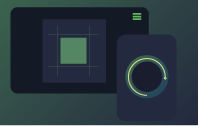Implementing applications
| Qt Design Studio attempts to meet your needs, whether you have previous experience with QML and coding or not. When you install Qt Design Studio, the default configuration allows you to start wireframing, prototyping, and validating UIs with very little effort. You can use the Code view to edit your component files ( |
- Designer-developer workflow
In Qt Design Studio projects, you work on UI files (
.ui.qml), while developers work on the QML and C++ source files in Qt Creator to create an application that you can build and run on target hardware. - Coding
Modify QML code in the Code view. The code editor understands the QML language as code, not just as plain text, so it can offer useful features, such as semantic highlighting, checking code syntax, code completion, and refactoring actions.
- Debugging and profiling
Qt Design Studio comes with a JavaScript debugger. In the Debug mode, you can inspect the state of your UI while debugging.
The memory and CPU power available on devices are limited and you should use them carefully. With QML Profiler, you can find problems in QML code.
Available under certain Qt licenses.
Find out more.


